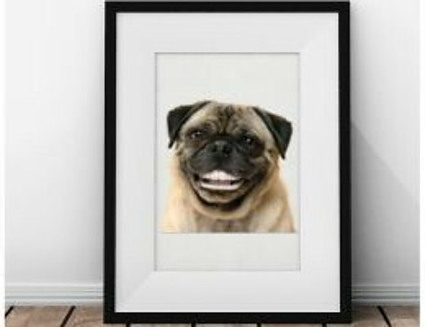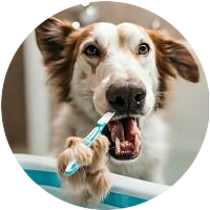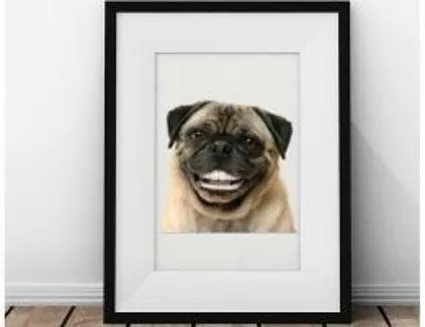
There are several different ways to clean your dog’s teeth at home as well as by a professional and there are many benefits to it as well. In this post we will explore many of them, let’s jump in.
I’m going to kick things off by underlining just how crucial dental hygiene is for your furry friend. This isn’t just about keeping those pearly whites sparkling; it’s also about ensuring their overall health stays top-notch. A dog’s mouth can be a gateway to a lot of health issues if not properly cared for. Bacteria in plaque and tartar can lead to serious problems like periodontal disease, which can have ramifications beyond bad breath, such as heart and kidney diseases.
You’re going to find out about several different methods to maintain your dog’s dental cleanliness, from traditional brushing to innovative dental health products. Each has its own set of advantages, and some may work better than others depending on your dog’s temperament and your lifestyle.
In my opinion, the foundation of good dental care is regular brushing. It’s the gold standard for preventing plaque and tartar buildup. But don’t worry too much if brushing isn’t the perfect fit for your pup; there are plenty of other efficient strategies to explore. Today, I’m going to take you through these options so you can choose something that resonates with you and your pet.
Now, let’s focus on the cornerstone of dental care for dogs: traditional brushing. With a range of tools and techniques at your disposal, you can always adapt your approach down the road. Next, we’ll look at the tried and true method of cleaning your dog’s teeth, ensuring a bright smile and a happier, healthier pooch.
Traditional Brushing: The Tried and True Method
If you want to tackle doggy dental care head-on, traditional brushing remains the gold standard. It’s the most effective way to clean your four-legged friend’s pearly whites and protect against plaque and tartar build-up.

Choosing the right tools is crucial. Human toothpaste can be harmful to your dog, so always opt for a dog-specific toothpaste with a flavor they’ll love. Similarly, dog toothbrushes are designed to be gentle on their gums and fit comfortably in their mouths.
For the step-by-step, start by getting your dog comfortable with having their mouth handled. Gently massage their lips and slowly progress to touching their teeth and gums. Once they’re comfortable, apply a small amount of toothpaste to the brush and lift their lip to clean each tooth using a circular motion. Begin with the canines and front teeth, as they’re less sensitive, before moving to the back teeth.
The rule of thumb is to brush your dog’s teeth at least three times a week, but if you can make it a part of your daily routine, even better. This frequency ensures optimal dental health and gets your dog used to the process.
Positive reinforcement is key. Reward your dog with plenty of praise and a dental treat after each brushing session. It creates a pleasant association and can make future brushings much smoother.
Alternative Dental Care Techniques for Dogs
So, we’ve talked about traditional brushing, but what if your dog isn’t a fan? Don’t worry too much about it; you’ve got options. Here I’m going to highlight some alternative dental care techniques that can help keep your dog’s teeth sparkling without the toothbrush battles.
First off, we’ve got dental chews and treats. These are a big hit with most dogs. They’re designed to reduce plaque and tartar build-up, and guess what? They are pretty effective, especially if used daily. I’ll go into what you want to look for in a dental chew because not all are created equal. Chewy.com, among others, are a great source for dental chews.
Here are some of the things that we look for:
- Ingredients:
-
- Choose treats with limited, natural ingredients. Look for options with high-quality proteins and minimal additives or preservatives.
- Avoid treats with artificial colors, flavors, or fillers.
- Texture:
-
- Opt for treats with a texture that helps clean your dog’s teeth. Dental treats with a slightly abrasive surface can help reduce plaque and tartar buildup.
- Chews that require a bit of chewing can also contribute to better dental health.
- Size and Shape:
-
- Choose treats that are appropriate for your dog’s size. Some dental treats come in different sizes to cater to various breeds.
- Select treats with shapes designed to promote chewing and reaching different areas of the mouth.
- ADA Seal of Acceptance:
-
- Check if the dental treats have received the American Dental Association (ADA) Seal of Acceptance. This indicates that the product has met certain standards for safety and effectiveness in promoting oral health.
- Caloric Content:
-
- Be mindful of the treat’s caloric content, especially if your dog is on a specific diet. Dental treats should be factored into your pet’s overall daily caloric intake.
- Veterinarian Approval:
-
- Consult with your veterinarian before introducing new dental treats into your dog’s diet. They can provide guidance based on your dog’s specific dental health needs.
- Effectiveness:
-
- Look for products that claim to reduce plaque and tartar. Some treats are formulated to help control bad breath as well.
- Allergies and Sensitivities:
-
- Consider your dog’s dietary restrictions and allergies when selecting dental treats. Choose options that align with your pet’s specific needs.
- Brand Reputation:
-
- Stick to reputable brands with a history of producing quality pet products. Read reviews or ask your veterinarian for recommendations.
- Frequency of Use:
-
- Be aware of the recommended frequency of use for the dental treats. Using them too often or in excess may lead to weight gain or other health issues.
Next on the list are water additives and dental sprays. If you’re looking for something easy, these might be your go-to. You’re just going to add these products to your dog’s drinking water or spritz them onto your dog’s teeth and gums. They help to break down bad breath-causing bacteria but shouldn’t be your only dental care tactic. Chewy.com, among others, is a great source for dental sprays for dogs.
Then there are dental toys. Choose something that resonates with you and your pup – toys that are fun to chew on and at the same time massage the gums and tackle tartar. For our Lucy, this has been the option we have chosen. These can be found at many different pet stores as we as online. We get ours at Chewy.com.
Here’s what we suggest to look for when choosing a dental chew toy:
- Texture:
-
- Look for toys with textured surfaces to help clean teeth and gums. Textures can aid in removing plaque and tartar.
- Size:
-
- Choose toys that are appropriate for your dog’s size. The toy should be large enough to prevent choking but small enough for them to comfortably chew.
- Durability:
-
- Opt for durable toys that can withstand your dog’s chewing habits. This ensures longevity and effectiveness in promoting dental health.
- Material:
-
- Select toys made from safe and non-toxic materials. Avoid toys with harmful chemicals or small parts that can be ingested.
- Chew Resistance:
-
- Consider toys designed to resist intense chewing. Some toys are specifically labeled as “indestructible” or “heavy-duty” for strong chewers.
- Purposeful Design:
-
- Choose toys with designs that encourage chewing from different angles. Some toys are shaped to reach specific areas of the mouth, promoting a thorough cleaning.
- Flavor:
-
- Some dental toys come with added flavors to make them more appealing to dogs. Choose flavors that your dog enjoys, but ensure they are safe and not overly artificial.
- Veterinarian Approval:
-
- Consult with your veterinarian before introducing new dental toys. They can recommend options based on your dog’s breed, age, and dental health.
- Variety:
-
- Provide a variety of dental toys to keep your dog engaged. Different textures, shapes, and sizes can cater to their preferences and ensure a more comprehensive oral care routine.
- Ease of Cleaning:
-
- Select toys that are easy to clean to maintain hygiene. Some toys are dishwasher-safe or have removable components for thorough cleaning.
- Interactive Features:
-
- Consider toys with added features like treat compartments or interactive elements. This not only entertains your dog but also encourages them to chew more, promoting dental health.
- Monitoring and Replacement:
-
- Regularly monitor the condition of dental toys. Replace them if they become damaged to prevent any potential harm to your dog.
By considering these factors, you can choose dental health toys that cater to your dog’s specific needs, promoting both oral hygiene and enjoyment.
Finally, let’s not forget about professional cleaning. This requires a trip to the vet, and it’s not just a casual visit. But it’s a crucial part of your dog’s dental care regimen. I’ll talk about the signs that it’s time for a professional clean and why it’s essential for your dog’s health.
You can always adjust your approach down the road, but starting these practices early can make a big difference. Remember, your dog’s dental health isn’t all about having fresh breath and a pretty smile; it’s about overall health. Plaque and tartar can lead to serious health issues if left unchecked.
Creating a Sustainable Dental Routine for Your Dog

I’m going to show you how to turn doggy dental care into a seamless part of your pet’s daily routine. Consistency is key when it comes to maintaining those pearly whites, and you’re going to find out about making it a regular, hassle-free experience.
First off, start by establishing a set time each day for dental hygiene. Choose something that resonates with you and your dog’s schedule. Maybe it’s after the morning walk or right before bed. The point is to create a routine that you can stick to without fail.
You can’t ignore the value of professional input. Regular veterinary dental check-ups are crucial for spotting any potential issues early on. Don’t worry too much about the frequency; your vet will recommend an exam schedule that’s suitable for your dog’s specific needs.
Monitoring your dog’s oral health is a big part of prevention. Keep an eye out for signs of dental problems such as bad breath, difficulty eating, or red and swollen gums. Address these issues promptly with your vet to nip them in the bud.
Lastly, don’t forget that dogs thrive on positive reinforcement. Reward your furry friend after each dental care session. This isn’t just about giving out treats; it’s also about providing plenty of affection and praise, making it an experience they look forward to rather than fear.
Remember, your first attempt at creating a perfect dental care routine doesn’t need to be your last. You can always adjust your approach down the road. I really hope that you’ll embrace the importance of dental care for your dog and enjoy the bonding time that comes with it!
We hope this information has been helpful. And as always, feel free to leave any questions or comments you may have.




